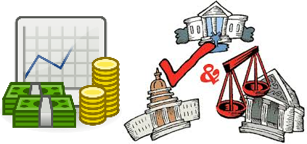Trickle Down Economics: A Supply Side Perspective
Definition of Supply Side Economics
Known as trickle down economics, it is based on the idea that reducing costs for businesses can lead to overall economic growth.
By making it more affordable for firms to operate, they can pass savings onto consumers through lower prices.
Mechanism of Economic Growth
When firms lower prices, consumers are more likely to purchase additional goods.
Increased consumer spending leads to a higher demand for products, prompting firms to expand production.
As production increases, firms need to hire more workers, leading to job creation and further stimulating household spending.
This cycle continues: more jobs mean more income, which results in increased consumer purchasing, thereby growing the economy.
Political Perspectives
Republican View:
Advocates believe that reducing taxes and cutting regulations allows firms to operate more efficiently.
The proposed plan is straightforward: cut taxes for everyone, deregulate industries, and let the market determine successful firms based on consumer demand.
The belief is that once taxes are lowered, firms can reinvest savings into their businesses or lower prices for consumers.
Democrat View:
Democrats, on the other hand, may not reduce taxes but instead provide subsidies to businesses.
The government hands out financial support to firms, allowing them to lower prices without necessarily improving operational efficiency.
This approach focuses on targeted financial assistance to select firms, with the hope that it will stimulate economic growth.
Government Involvement
Republican Policy:
Emphasizes a hands-off approach, reducing government interference in the market.
Once tax cuts and deregulations are in place, Republicans advocate for minimal ongoing government involvement, allowing consumers to dictate market success through their spending choices.
Democrat Policy:
Involves more active government participation in the economy.
The government selects specific firms and industries for financial support, which can lead to a perception of favoritism or inefficiency.
Critics argue that this could create a system where money is not directed to the most productive businesses, but rather to those that are politically connected.
Efficiency of Subsidies
The effectiveness of government subsidies is questioned.
Critics point to instances where funds are allocated to less efficient firms, detracting from overall economic productivity.
Example: The Biden Administration's funding choices have been challenged for not supporting highly productive firms like Tesla while directing resources to less efficient projects.
Consumer Choice and Market Dynamics
In a supply side economy, consumer preferences ultimately decide which firms thrive.
Even if inefficient firms receive tax breaks or subsidies, they may fail if consumers do not support them through purchases.
Over time, the market can "clear out" ineffective businesses, leading to a more efficient economic landscape.
Long-Term Economic Impact
Sustained government support for unproductive firms can lead to increased taxpayer burden, reducing disposable income for consumers.
Critics warn that this can stifle overall economic growth, as resources are not being used efficiently.
The long-term viability of an economy relying heavily on subsidies versus one driven by consumer choice remains a critical debate.
Future Implications
The video contrasts the economic policies of the previous Democratic administration with potential Republican strategies.
It raises questions about the effectiveness of subsidy-based growth versus supply side economics centered on tax cuts and deregulation.
Observations are made about the anticipated outcomes of the two approaches, emphasizing the need for consumers to make informed choices that shape the economic landscape.


